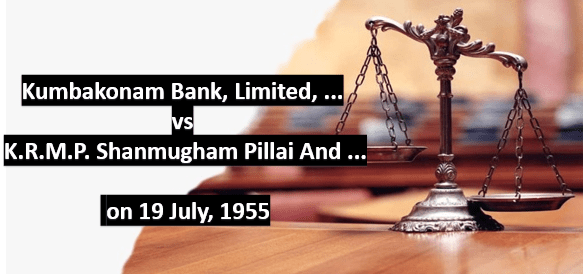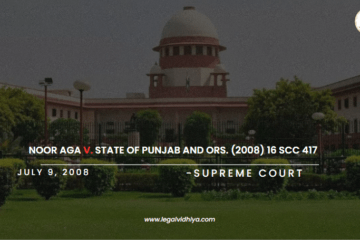
Kumbakonam Bank, Limited, … vs K.R.M.P. Shanmugham Pillai And … on 19 July, 1955
| OVERVIEW OF THE CASE | |
| Case Name | Kumbakonam Bank,Limited V k.R.M.P. Shanmugham Pillai And |
| Citation | (1956) 1 MLJ 58 |
| Date of Judgement | 19 July 1955 |
| Petitioner | Kumbakonam Bank,Limited |
| Respondent | K.R.M.P. Shanmugham Pillai And |
| Bench | Govinda Menon,J ,Ramaswami, J |
| Court | Madras High Court |
Introduction
In the current instance, it is undeniable that commerce served as the family’s primary source of income. As a result, the debt created by the first defendant through his business dealings must be deemed to bind defendants 2 through 4. According to me, the appeal must be granted with costs.This appeal was filed in opposition to the ruling and decision rendered in O.S. No. 52 of 1949 by the learned Subordinate Judge of Tanjore.
Facts
The first defendant is the manager of a combined Hindu family that includes defendants 1 through 4. They were a trade family, and their kulachara was running a grocery store. Regarding this family-run business, the first defendant has been borrowing from the plaintiff Kumbakonam Bank, Limited under promissory notes and overdrafts and has executed security bonds; these sums, when the accounts were cast and the suit was calculated, came to Rs. 12,275-14-7. The first defendant was sued personally, along with defendants 2 through 4, for their respective portions of the joint family properties, which had been pledged as security to the plaintiff bank. The plaintiff bank initiated the lawsuit in an effort to recover the stated amount. The execution of the security bonds, promissory notes, passing of the consideration, and the sum for which the lawsuit has been filed were not contested. The only issue that was brought up for discussion before the lower court was whether defendants 2 through 4 were also subject to the suit debt and if their interests in the family assets would be subject to payment of the suit debt. Defendants 6 and 7, the following encumbrancers, were sent to separate lawsuits. The fifth defendant is unimportant to us because the plaintiff cleared him of all charges. The Kumbakonam Bank, the unsuccessful plaintiff, appeals the section of the ruling that forbids charging the shares of defendants 2 to 4 on the properties covered by the security bond.
Issues
The question for consideration is whether his sons can be made liable for the debts incurred in regard to the running of that business?
Contentions
Petitioner-It is evident from Manu Chapter VIII placitum 41 and Yajnyavalkya 360–361 that individuals who created the laws had a different understanding of trading families. In Raghunathji Tarachand v. The Bank of Bombay (1909) I.L.R. 34 Bom. 72 at page 77, Chandavarker, J. made note of this. In my opinion, there needs to be a distinction made between families that prosper and rely entirely on agriculture or the learned professions and those whose members are completely devoted to the calling of trade or commerce.
Respondent-Therefore, in the case of a hereditary trading family where there has been an expansion or change in the ancestral business, the only factor is whether the specific business in question is a legitimate expansion or reconstruction of the business or whether it is of such a speculative character entailing unusual hazards against which the interests of the minors and other categories of persons have to be protected by law.
Judgement
According to Sir Dinshah Mulla’s decision in the Benares Bank case (1932) 63 M.L.J. 92: L.R. 59 I.A. 300: I.L.R. 354 All. 564 (P.C.), the subject of consideration was a Theka business as well as building contracts under the Public Works Department that were started by a member of a joint Hindu family that was clearly not a trading family. Significant observations may be found on pages 570 and 571. Nowhere is it mentioned that the kulachara of the family was commerce.
In the end, it appears that the Allahabad, Patna, and Lahore High Courts’ interpretation of the decision in Banares Bank’s case (1932) 63 M.L.J. 92: L.R. 59 I.A. 300: I.L.R. 54 All. 564 (P.C.) is the logical and proper interpretation. The Privy Council’s proposal for a new business cannot be interpreted as a technical or universal regulation with no exceptions. As stated in the Bombay decisions Ghulam Khaja v. Shivalal (1937) 40 Bom.L.R. 381 and Jagadish Prasad v. Ambashankar (1933) 36 B.L.R. 625 as well as the Madras decisions Subbaratnam v. Gunavanthalal (1937) 1 M.L.J. 224 and Chockalingam v. Muthukaruppan (1938) 2 M.
Conclusion
Consequently, we determine that the experienced Subordinate Judge was unjustified in ruling that defendants 2 to 4 are not bound by the security bonds Exhibits A-1 to A-3, which are true and valid. We conclude that the plaintiff is right on point 2 and in the lead. This appeal is granted, but at a cost. The lower court’s ruling is adjusted accordingly, and the plaintiff will receive the ruling that was requested in the plaintiff. Three months are allowed for payment.
Reference
●https://indiankanoon.org/doc/1343364/
●https://legaldata.in/court/read/2018832
Written by Ishita Singh,Chotanagpur Law College, Ranchi,2nd semester, an intern under legal Vidhiya.




0 Comments